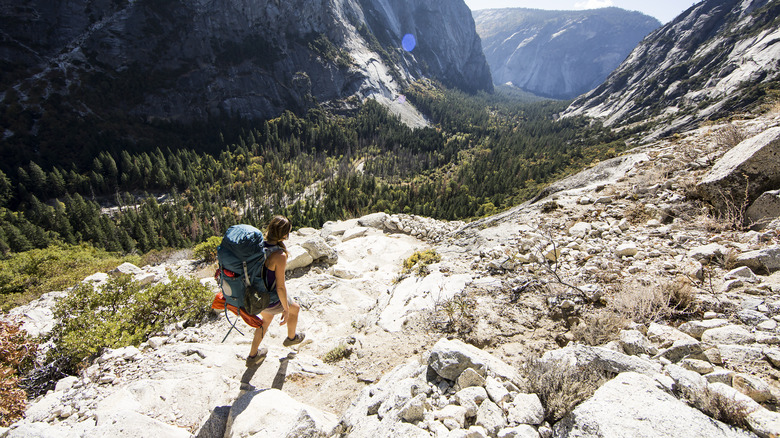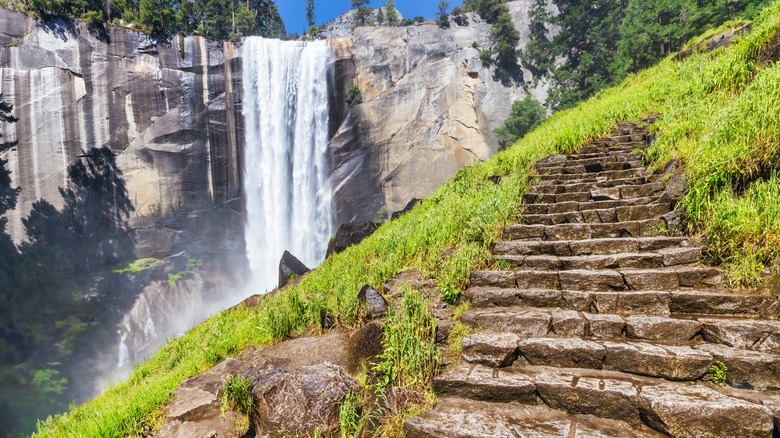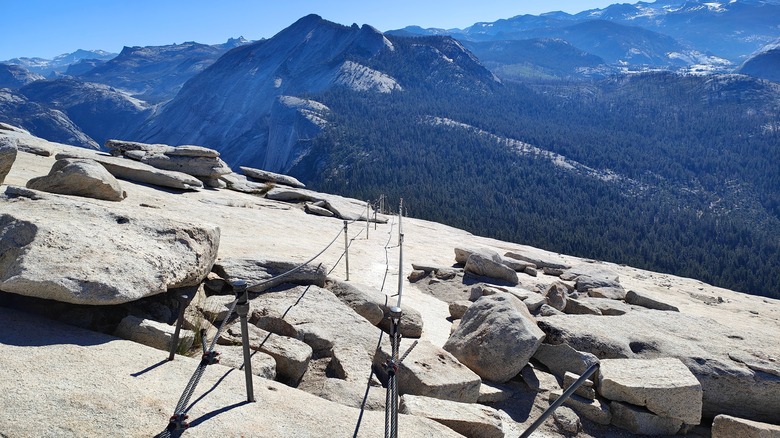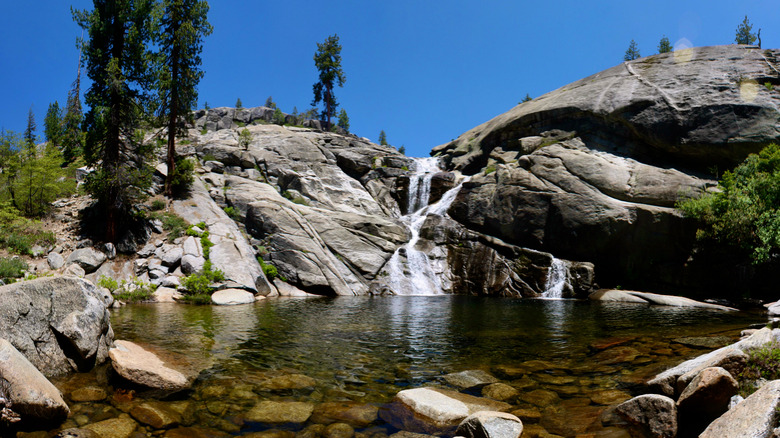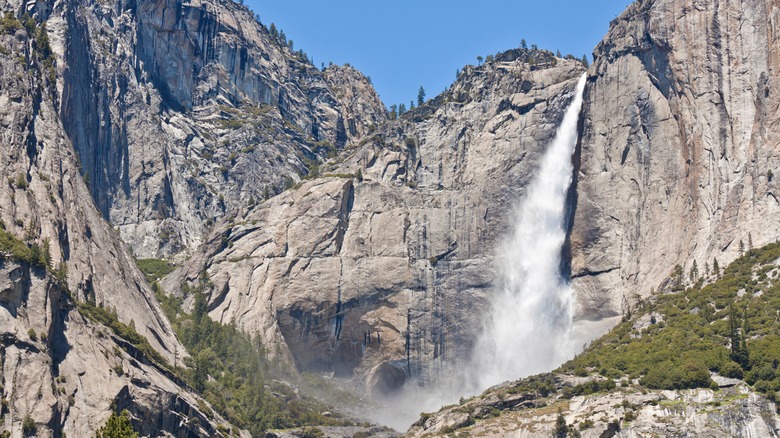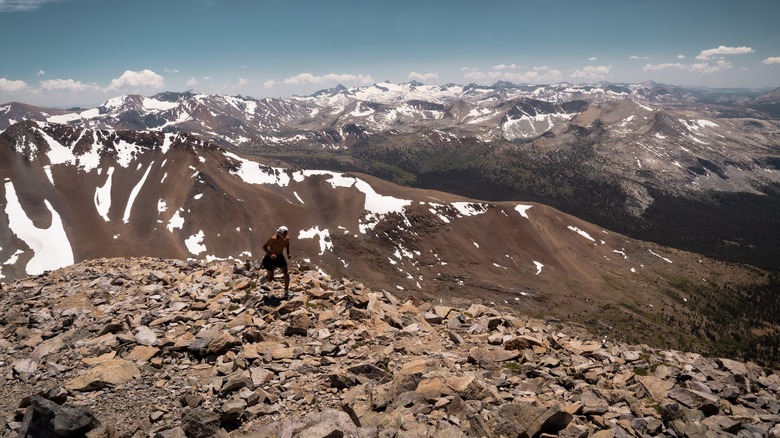The 5 Most Dangerous Hikes In Yosemite National Park
Encompassing nearly 750,000 acres, Yosemite National Park is a haven for all those who love nature and the great outdoors. Yosemite, located in central California's Mariposa County, is especially alluring to hikers. The park has hundreds of miles of hiking trails that are ripe for exploration. This includes Taft Point, which is only open for half of the year and boasts the best views in Yosemite. There are also hiking trails that are accessible to wheelchair users, such as the Lower Yosemite Fall Trail. However, behind the beauty lies great peril. Hikers run the risk of falling, getting lost, and even dying in Yosemite.
The likelihood of these threats increases when hikers go off trail, cross guardrails, or when they are unexpectedly met with a storm. Wet conditions can lead to slipping, and unfortunately for hikers, thunderstorms are common in Yosemite. This is especially true in the summer, the park's peak season. In fact, this factor has led to criticisms of the National Park Service with hikers noting that more can be done to increase their safety.
It's little wonder that Panish | Shea | Ravipudi LLP, a law firm, named Yosemite one of the deadliest national parks in the country. Needless to say, there are certain hikes in the park that equate to adventure, but also danger. Some have nearly lost it all to experience these hikes, while others have not been as lucky.
The Mist Trail
Yosemite National Park's Mist Trail traverses a total of 6.4 miles. It reaches to the top of Vernal Fall and Nevada Fall. A stairway leads to Vernal Fall, which is located on the Merced River, known for its strong current. The Mist Trail provides breathtaking views of these roaring natural wonders. But this can also be a recipe for disaster. According to an article from the Los Angeles Times, 14 individuals on the Mist Trail died between 2003 and 2013, becoming a casualty of Vernal Fall. This includes three tourists in 2011 who decided to cross safety rails for a swim in the Merced River. A slip ultimately caused them to plummet over Vernal Fall.
However, there's more danger that can be encountered along the trail. On Christmas Day 2018, Joshua Brock Conner was hiking the Mist Trail near Nevada Fall when he accidentally fell down Silver Apron, a rock formation.Tragically, Conner, who was 32-years-old, sustained injuries to his head and died. Shortly after, in February 2019, 56-year-old Xuan Wang died on the Mist Trail due to falling rocks.
One reviewer on Yosemite Hikes also cautions hikers against the stairway to Vernal Fall. They wrote, "This trail is dangerous and should be closed. The portion of the trail that ascends over slippery, wet granite steps is always crowded, with no handrails, and huge steps that were probably made for mules, not people. Don't go above Vernal Falls on this trail if you value your life."
Half Dome
Half Dome is a seasonal trail that is 14 to 16 miles long. It features the Half Dome cables, vertical ropes installed on the rock that aid hikers to slowly pull themselves up the summit. Of course, this does not come risk-free and hikers can fall to their deaths. Per The Mercury News, this was the case for 10 individuals between 1948 and 2024. For example: 20-year-old Grace Rohloff died in July 2024 while she was traversing the Half Dome cables with her father, Jonathan Rohloff. Days after the tragedy, he told SFGATE that a storm broke out of the blue during their descent, with Grace saying, "Dad, my shoes are so slippery," before falling to her death.
As mentioned, thunderstorms and weather changes are routine in Yosemite. That said, many of the fatalities that have transpired on the Half Dome cables have been related to the weather and have occurred when the hikers were descending. As Steve Bumgardner, a Yosemite ranger, explained in a safety video (via SFGATE), "Once water falls on that route where the cables are, it becomes incredibly slick. The cable itself is very difficult to hold on to when it's wet."
This can catch hikers off guard and can cause a gridlock as they make their way down the cables, heightening the risk of slipping. Yosemite's website warns against doing this hike in wet conditions and due to the peril it poses, some critics believe that the cables should not exist at all.
Chilnualna Falls
Featuring five drops, Chilnualna Falls is a sight to see. Although it is one of Yosemite's lesser-known landmarks, this does not make it any less worthy than other renowned waterfalls in the park, such as Vernal or Nevada Falls. The hike to Chilnualna Falls is a little over 8 miles long, with several reviewers on AllTrails noting that the 2,200-feet elevation gain makes it an arduous journey. With that said, Chilnualna Creek, found along the trail, should be approached with caution. A 24-year old hiker, Hayden Klemenok, fell into this body of water in July 2023.
He was found in the creek days later, but did not survive. Speaking to Your Central Valley, Steve Lyon, a park ranger, explained the incident by saying, "The area where they were and all that bare granite gets real slippery and all it takes is just a little bit of moisture on that granite for it to become real slick." For this very reason, the National Park Service warns that hikers should refrain from wandering off the trail. Otherwise, calamity could unfold.
This is what happened in 2012 when two hikers fell several feet by Chilnualna Falls after venturing off-trail. The pair survived, but they had to be airlifted to receive medical treatment. A similar incident transpired in 2016. A man hiking off-trail close to Chilnualna Falls fell, broke his femur, and sustained other injuries. He received onsite medical treatment, but was not evacuated until the following day.
Upper Yosemite Falls
There appears to be a recurring pattern with Yosemite's hikes: Those involving waterfalls are treacherous. Upper Yosemite Falls is no different. Yosemite Falls is the tallest waterfall in North America. Naturally, this 7.2-mile hike (round-trip) has its challenges. "This trail is not for the faint of heart. So many rocky switchbacks, sand slides and moving gravel but oh so worth it when you reach the top," states an AllTrails review. Like the previously mentioned hikes, falls (which account for much of the fatalities at Yosemite) are not an uncommon occurrence at Upper Yosemite Falls.
A woman hiking near the trail fell 25 feet in 2015. The hiker survived, but did sustain injuries to her pelvis. Tragically, "Alice" Yu Xie died while hiking Upper Yosemite Falls in early 2021. In both of these cases, the causes of the falls were not revealed. However, it is known that the presence of slick rocks can be found at Upper Yosemite Falls. This led one unnamed hiker to nearly fall down the waterfall in 2014. While he managed to avoid the main fall, the hiker injured himself and developed hypothermia, ultimately needing to be rescued via helicopter. Nevertheless, if you plan on doing this hike, it's important to take your time — and whatever you do, don't wander off the trail. These simple suggestions could decrease the chances of injuries or worse.
Mount Dana
Mount Dana is the second-highest mountain in Yosemite. With its peak having an elevation of over 13,000 feet, hikers still trek the trail that leads to its summit. Unsurprisingly, Mount Dana is considered to be one of Yosemite's most difficult hikes. AllTrails users agree with this sentiment. Several reviewers state that one of the biggest risks presented by this 5.3-mile trail is altitude sickness. If you're unfamiliar with this condition, hikers can develop altitude sickness due to a lack of oxygen found at high elevations.
Symptoms vary and include everything from dizziness, vomiting, and even death. "I still feel the altitude sickness, light headache till the next day, drank about 4 liters of water," wrote one AllTrails reviewer. Another stated, "I was getting altitude sickness quite early on and didn't want to push. so turned back." Dinesh Chandra wrote in a post on LinkedIn that he opted to hike Mount Dana to train to hike to Everest Base Camp, where altitude sickness is common and sometimes fatal.
Chandra recounted how he, along with his wife and another individual, became lost on their hike hours in the dark. Although the group was rescued, Chandra revealed that he may have underestimated the hike. This is all to say that Mount Dana is not for inexperienced adventurers. If you enjoyed this story, check out the iconic Yosemite climb that is one of the most dangerous in America.
